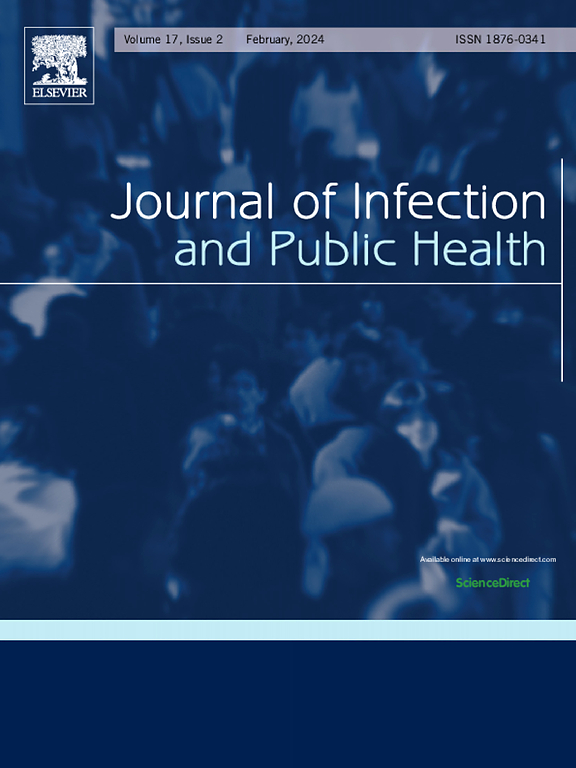日本大流行后爆发的麻疹,2024年
IF 4
3区 医学
Q1 INFECTIOUS DISEASES
引用次数: 0
摘要
背景:日本于2024年3月1日报告了一例输入性麻疹病例,随后出现了涉及与该指示病例乘坐同一航班的个人的其他病例。除了对大流行后传播动态进行实时评估外,我们还旨在阐明2024年日本麻疹疫情的流行病学特征。方法基于公共卫生中心通报的确诊病例数据进行分析。为了估计有效繁殖数(Rt),我们从英国的疫情数据集中检索了序列间隔分布。我们将传染性特征估计为发病时间的函数,并对二次传播时间进行反向投影以计算rt。我们基于接触者追踪信息重建了传播树。结果截至2024年5月13日,全市共报告麻疹病例24例,其中13例疑似从指示病例获得感染。2月23日,即指标病例自我隔离前一天,估计Rt达到峰值14.1(95 % CI: 1.2 ~ 33.4)。Rt随后下降,受影响的县公布了诊断病例,提高了对麻疹疫情的认识。结论1例输入性麻疹病例导致了一次超传播事件,但防止了进一步的二次传播;指示病例自我隔离,公共卫生中心提高了对疫情的认识。目前计算Rt的简单方法对监测任何直接传播的传染病的未来爆发是有用的。本文章由计算机程序翻译,如有差异,请以英文原文为准。
Post-pandemic outbreak of measles seen in Japan, 2024
Background
An imported case of measles was reported on 1 March 2024 in Japan, followed by additional cases involving individuals who took the same flight as the index case. In addition to post-pandemic real-time assessment of the transmission dynamics, we aimed to clarify the epidemiological characteristics of the 2024 measles outbreak in Japan.
Methods
We analyzed confirmed-case data based on notifications from public health centers. To estimate the effective reproduction number (Rt), we retrieved a serial interval distribution from an outbreak dataset in the United Kingdom. Estimating the infectiousness profile as a function of time since illness onset, we back-projected the time of secondary transmission to compute the Rt. We reconstructed the transmission tree based on contact tracing information.
Results
As of 13 May 2024, a total of 24 measles cases were notified during 2024, among which 13 were considered to have acquired the infection from the index case. The estimated Rt peaked at 14.1 (95 % CI: 1.2–33.4) on 23 February, the day before the index case self-isolated. Rt subsequently declined, and public announcements of diagnosed cases were made by the affected prefectures, raising awareness about the measles outbreak.
Conclusions
An imported measles case led to a super-spreading event, but further secondary transmission was prevented; the index case self-isolated and awareness was raised about the outbreak by public health centers. The present simple method of computing the Rt is useful for monitoring future outbreaks of any directly transmitted infectious disease.
求助全文
通过发布文献求助,成功后即可免费获取论文全文。
去求助
来源期刊

Journal of Infection and Public Health
PUBLIC, ENVIRONMENTAL & OCCUPATIONAL HEALTH -INFECTIOUS DISEASES
CiteScore
13.10
自引率
1.50%
发文量
203
审稿时长
96 days
期刊介绍:
The Journal of Infection and Public Health, first official journal of the Saudi Arabian Ministry of National Guard Health Affairs, King Saud Bin Abdulaziz University for Health Sciences and the Saudi Association for Public Health, aims to be the foremost scientific, peer-reviewed journal encompassing infection prevention and control, microbiology, infectious diseases, public health and the application of healthcare epidemiology to the evaluation of health outcomes. The point of view of the journal is that infection and public health are closely intertwined and that advances in one area will have positive consequences on the other.
The journal will be useful to all health professionals who are partners in the management of patients with communicable diseases, keeping them up to date. The journal is proud to have an international and diverse editorial board that will assist and facilitate the publication of articles that reflect a global view on infection control and public health, as well as emphasizing our focus on supporting the needs of public health practitioners.
It is our aim to improve healthcare by reducing risk of infection and related adverse outcomes by critical review, selection, and dissemination of new and relevant information in the field of infection control, public health and infectious diseases in all healthcare settings and the community.
 求助内容:
求助内容: 应助结果提醒方式:
应助结果提醒方式:


